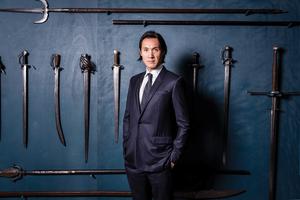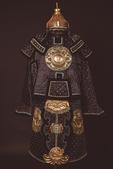 Way of the Sword co-curator Hing Chao says the sword can be seen as an instrument used to protect people as opposed to causing harm. (PHOTO PROVIDED TO CHINA DAILY)
Way of the Sword co-curator Hing Chao says the sword can be seen as an instrument used to protect people as opposed to causing harm. (PHOTO PROVIDED TO CHINA DAILY)
If there is one thing the East and West have in common, it is their epic battles and the noble warriors who fought them. As successive Chinese emperors pushed into territories across Asia, the Roman Empire expanded beyond Italy to engulf much of Europe, the Middle East and North Africa. Conquests would not have been possible without the sword and the expertise it took to wield it with deadly precision.
Way of the Sword: Warrior Traditions in China and Italy is Tai Kwun’s latest exhibition and chronicles the sword’s impact upon civilization over the years. The show is co-presented by the Institute of Chinese Martial Studies and co-organized by The Martial Art Museum, City University of Hong Kong, International Guoshu Association and Ma’s Tongbei Martial Studies in partnership with the Consulate General of Italy in Hong Kong and the Hong Kong Culture Festival, and supported by the Hong Kong Arts Development Council, among others.
Curators Hing Chao and Roberto Gotti spent two years choosing materials that span two millennia. “The first prehistoric depictions of the sword can be found at Val Camonica, a place where people of different cultures met well before the Silk Roads were established,” notes Chao.
 New media curator Jeffrey Shaw created a range of interactive and immersive multimedia experiences for the Way of the Sword exhibition. (PHOTO PROVIDED TO CHINA DAILY)
New media curator Jeffrey Shaw created a range of interactive and immersive multimedia experiences for the Way of the Sword exhibition. (PHOTO PROVIDED TO CHINA DAILY)
The valley in northern Italy’s Alps is the site of Europe’s largest concentration of rock carvings, with etchings of warriors and swords that date back thousands of years. A film capturing the rock carvings in situ can be seen alongside photos on the mezzanine level of Tai Kwun’s Duplex Studio.
“This is the first multimedia exhibition on the topic combining video and still images,” says Jeffrey Shaw, the exhibition’s new media curator.
For the first time in Hong Kong, more than 50 ancient swords and over 20 martial arts manuscripts and books dating back to the 16th century are on public display. “The lower level of the Duplex Studio takes visitors through the sword’s history, with the red section displaying Chinese artifacts and the blue section Italian ones,” says Chao. “Joining them in the middle is a white double-sided display case showcasing both cultures. The mezzanine level is devoted to martial arts, with a combination of video and still images.”
Some of the swords on display are embellished with expensive metal, like gold hilts. Ceremonial armor reinforces the pageantry associated with brave warriors. For example, a 19th-century costume of a Manchu officer assigned to protect the emperor is decorated with dragon designs in gold thread on blue satin silk.
 Costume of a 19th-century Manchu officer assigned to protect the Chinese emperor on display at the Way of the Sword exhibition in Tai Kwun. (PHOTO PROVIDED TO CHINA DAILY)
Costume of a 19th-century Manchu officer assigned to protect the Chinese emperor on display at the Way of the Sword exhibition in Tai Kwun. (PHOTO PROVIDED TO CHINA DAILY)
Achille Marozzo’s Opera Nova dates back to 1528 and outlines the battle postures of Italian Renaissance martial arts through linear drawings. “Opera Nova is our most important artifact here,” states Chao. To bring the manuscript to life, Shaw and Sarah Kenderdine developed Linear Navigator, which allows viewers to watch sword techniques through digital animation.
On the mezzanine level, film scenes featuring Italian and Chinese martial arts masters demonstrating sword fighting techniques are played on rotation, giving viewers a chance to note the cultural differences between the two. Images by photographer Almond Chu and other Hong Kong artists highlight the power of different weapons as they are wielded.
“With the rise of gunpowder in China, the sword was eventually replaced by the knife,” says Chao. “The sword can be seen as an instrument of protection, while the knife is an instrument of harm.”
“Way of the Sword was designed to be an immersive museum experience,” says Shaw. “Sometimes, to understand our own culture, we have to view it through the lens of a foreign one.”


